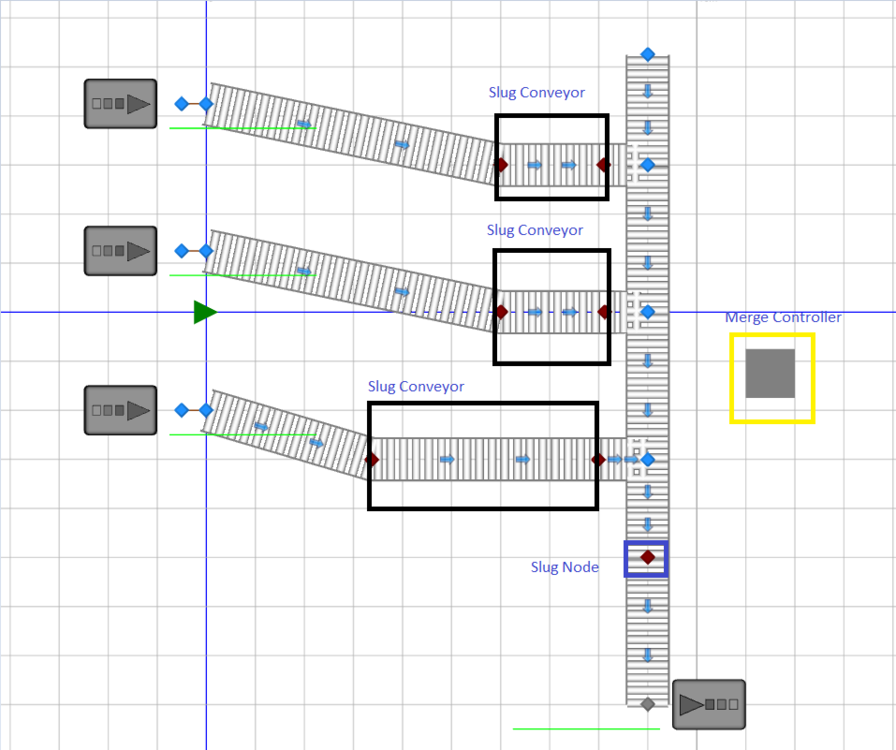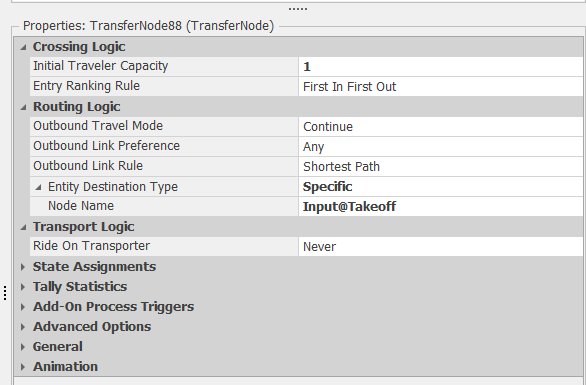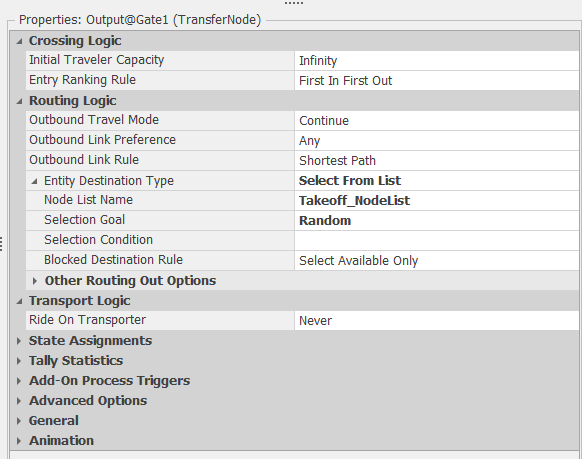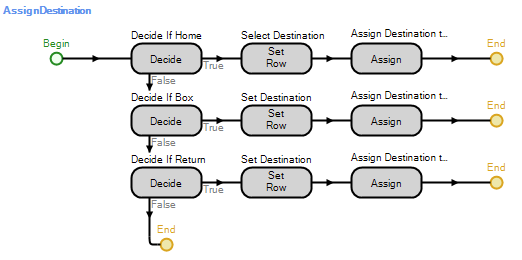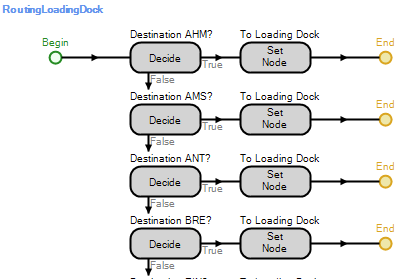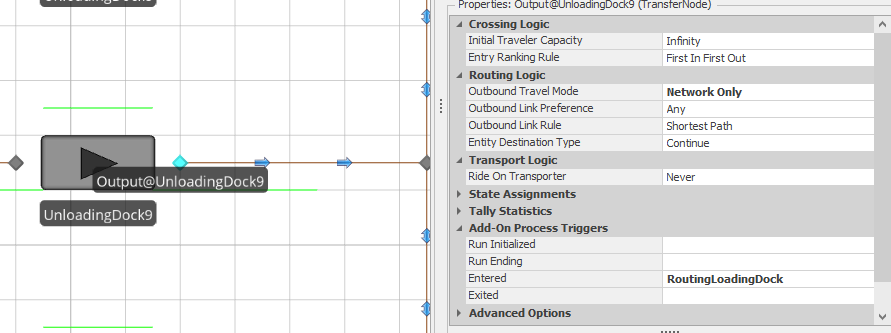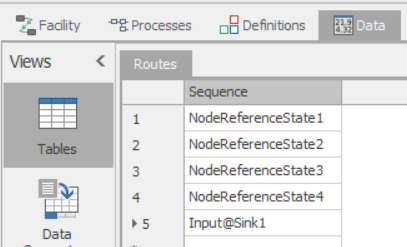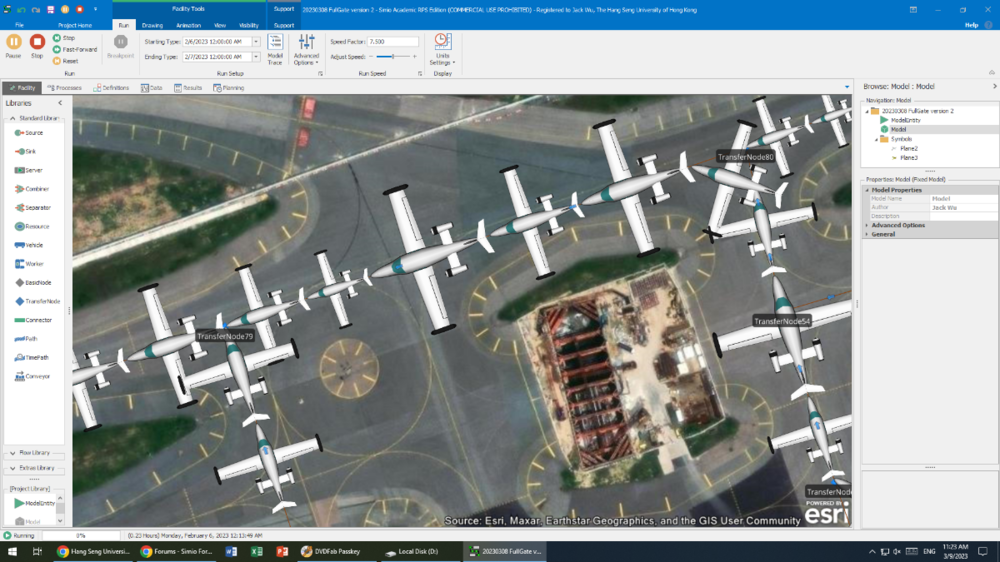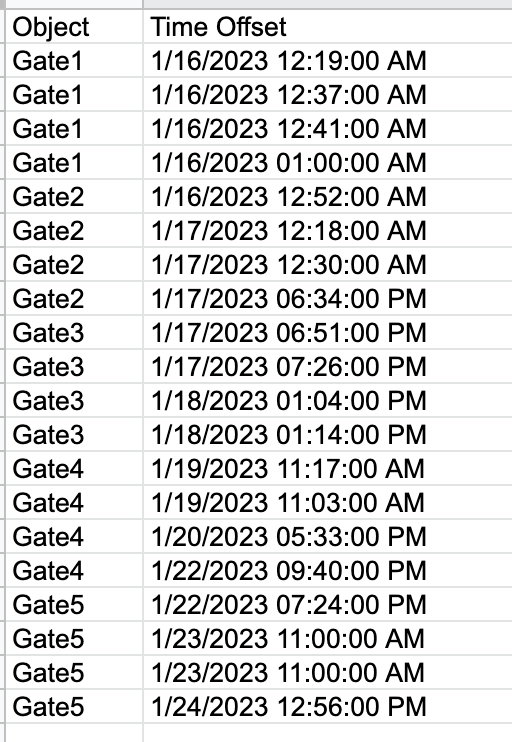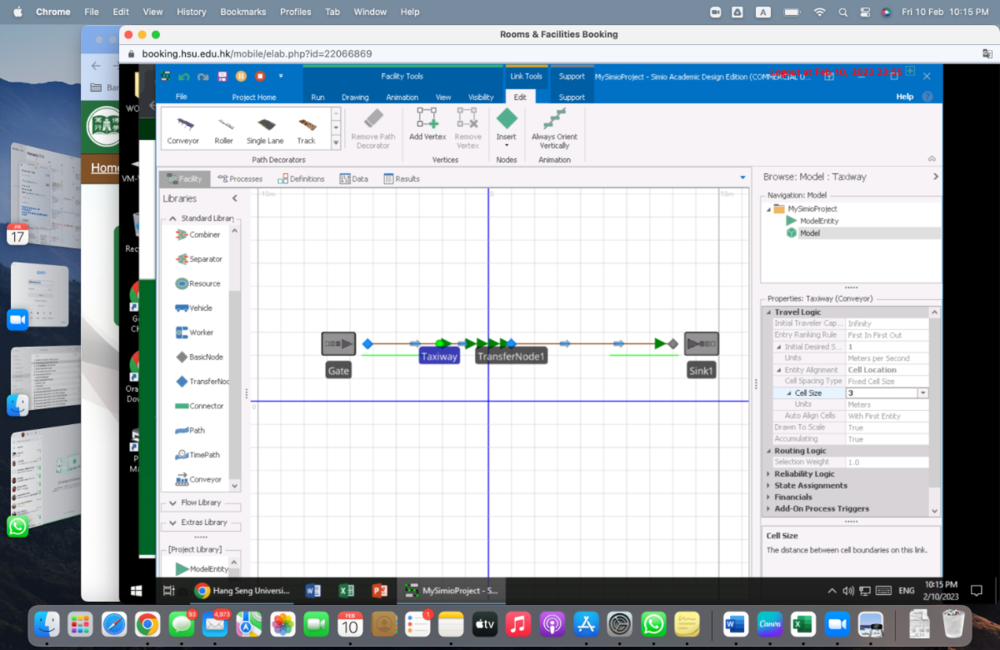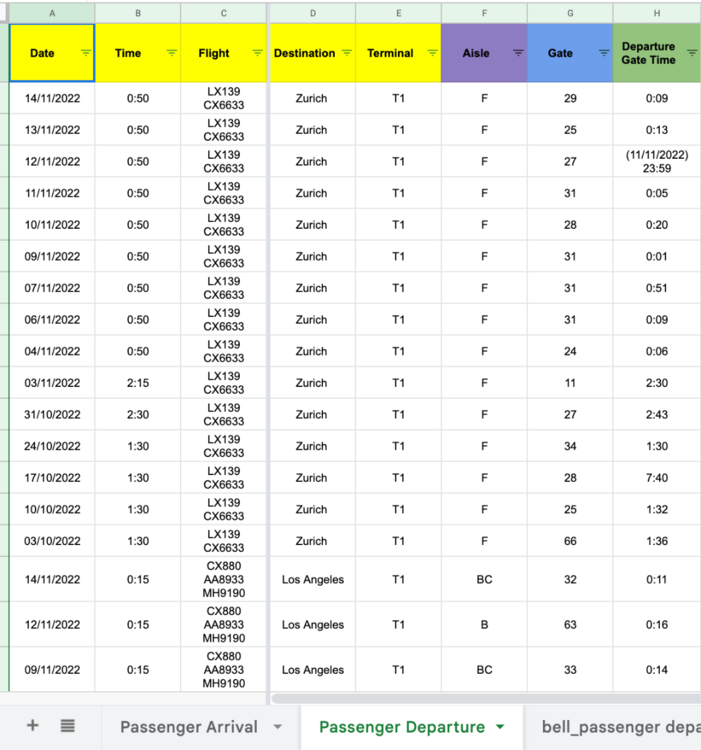Search the Community
Showing results for 'entity network turn'.
-
ConveyorLibrary.spfx Simple conveyor library with a merge controller, slug conveyor, Slug Node and a Photo Eye. Library has two example models. A MergeControllerModel and a PE_ExampleModel. Merge controller,Slug Conveyor and Slug Node are used together to develop a slug merge. ConveyorLibrary.spfx On the slug conveyor you can specify the size of the slug. Slug node controls when the next slug is to be released. As soon as last entity in slug crosses the slug node it will send a signal to merge controller to release the next slug. Ending node of the slug conveyor has to be a slug node. Conveyors before and after slug conveyor are regular conveyors. These objects have not be extensively tested. These can be used to develop other conveyor related objects.
-
Hi @jzhou, how would this work if I want to refer to the MemberOutput Node of a separator in an expression? I get lost at the following expression: Entity.Location.Parent.Node.AssociatedObject.Separator.Output.[what comes next?]
-
Hello River, I downloaded your files. The Gate512 was missing. I removed the information in the "30 Departure.xlxs" file that I can run the model ;-). Generally I understood how it works. Answer to your first question: I think you mean these two ways, right? From the left and from the right. In this case I saw that you used the "Routing Logic" in like all Transfernodes. The Outbound Link Rule is "Shortest Path" and you set the "Node Name" to "Input@Takeoff" Simio is using everytime the shortest link path now. Like in the screenshot below: In my opinion it would be better to set the destination once after the Entity got created in the Source for example :-). There are different ways to do that. In your model I removed all Routing Logic in the Transfernodes and used the Routing Logic only in the Output-TransferNodes of the Sources. In Simio you need only to use one time a SetNode-Step or a Routing-Logic to set the destination of an Entitiy and Simio will follow the paths or travel in the FreeSpace. You can use for example a NodeList with 2 different destinations and this Routing-Logic: With the "Selection Goal" Random Simio will randomly choose the destination from the NodeList. I uploaded you your model with the changes as an example: Problem on the taxiway version 17A.zip What did I changed? 1) I removed the Routing Logic in all TransferNodes. 2) I added new Routing Logic to the TransferNodes of the Output-Node of the Sources. 3) I added a NodeList with 2 new Nodes. 4) In the two new Nodes I used a Nodes-Entered-Process and a Transfer-Step to transfer the Entity to the Input of the Sink. Answer to your second question: You can change the destination of an Entity any time. In the Path (Link) you have a function called "NumberTravelors" for example to get the number of travelors currently on this path. So you can use a Expression like "Path123.NumberTravelors < 2". This can be used to decide if a way is full allready that the other way get selected. Or you can use a Integer-State and count up and down. I would use a Node-Entered-Process in the last possible node with a Decide-Step and two SetNode-Step in this case :-). I hope my answer will help you. When you have any other question, you are welcome! Best regards Pascal
-
Thank you Dave! Inspired by your approach, I defined two Node Reference State Variables for the Entity: EndDestination and NextNode. In the model Processes, I first determine the Entity State Variable EndDestination based on a DataTable with probabilities per destination node. Then, at routing decision points, I have created processes that evaluate the EndDestination node and set the next node for the unity based on that. Although it requires a bit of 'hard modeling', it works like a charm! Thanks
-

Changing Sequence table over time
dsturrock replied to antonio6vieira's topic in SI General Discussions
I have attached a simple model using model states to illustrate. I think it should work in a similar fashion using entity states. First, I define the states: Then use those states as Sequence destinations: Until you provide each of those states a value, the Sequence will make no sense and the entity won't know where to go. So on the Source I use an Assign to initialize all the values. This will direct the entity sequentially through Servers 1-4, and then to the Sink: Finally, just to illustrate the technique, on the output node of Server3, I interrupt the normal sequence by Assigning it to instead go to Server5 as its 4th step: If you convert these states to Entity states instead (I was just lazy), I think it should work the same but allow you to selectively override any Sequence Step at any time. UsingStatesInSequences.spfx -
Hi David, I am trying to get your option 3 to work in my model, as the solutions sounds brilliant. I created an Add-On Process that probabilistically assigns destinations to the Entity and by assigning the destination node to the Entity's State Variable MyDest. In the Routing Logic, I've set the Initial Sequence to the sequence table called Routes that holds all possible routes. However, the entities now only follow the first sequence Routes (Input@LoadingDock9, Input@Sink_HTB), whereas Entities with the destination Input@Sink_RTM should follow the sequence Input@LoadingDock10, Input@Sink_RTM. How can I let the Entity follow a specific sequence from my Sequence Table Routes?
-
Server Capacity Depends on # of Seized Resources
Liz Millar replied to nObeso23's topic in SI General Discussions
Hi Nicolas, I would investigate the Server property called Initial Capacity. This sets how many units of capacity are going to be available for the Server. You could also change this during the run by Assigning the Server's CurrentCapacity State Variable. I suggest checking out the SimBit titled "Worker Uses Work Schedule". You can access the SimBits in the Support ribbon in Simio. In this SimBit, I recommend changing the Initial Capacity for the Servers. You could set them to '6' or any value. When you run, you will see that the entities only move into the Process Station when they have successfully Seized the Secondary Resource. So even though there is 6 units available only 1 will be use when the Worker is able to process the entity. You can also experiment with giving the Worker a different Initial Number In System value so there can be more Workers. You will still see the same behavior; the number of entities that move into the Server for processing will be the number of Workers that were available to be seized. Happy Modeling! Liz -
Hi everyone, I am trying to model entities moving from 10 origins (sources) to 10 destinations (sinks). The entities are simultaneously created according to a certain mix (Entity1 (85%), Entity2 (10%), and Entity3 (5%). However, the number of entities created per event is according to a certain distribution. There is an OD-matrix that captures the number of entities moving from origin to a specific destination. Let's say there are 10 destinations, than the destinations of the Entities are determined according to the OD-matrix: Entity1 and Entity2 can move to any of of the sinks. Entity3 can only move to one specific sink. One solution I came up with was to add weights to Connectors and assign destinations using TransferNodes, but I think that this is very inefficient. I then started to work with DataTables, but I cannot figure out how to probabilistically assign the destinations of the entities. My question is: how to model the probabilistic destination assignment of Entities using DataTables in such a way that it is relatively easy and flexible to add or remove Sources/Sinks? I have added the model for you to see, I hope that you can help me! Many thanks in advance Simple_OD_creation.spfx
-
This is problematic in Simio because Simio considers only entity length (not width) and only when on a Path or Conveyor. I think the first thing to do is fix the nose to tail problem. If you happen to use Conveyors to model this, there are built-in features to manage spacing while stopped and different spacing while moving. But unfortunately Conveyors are limited to a single direction, so are perhaps not appropriate if this is a bi-directional taxiway. If you are using Paths, you can fix this by making each plane longer when you draw it. For example, if you are drawing a plane that is 50M long and you want it to stay at least 10M behind the plane in front of it, place a nearly invisible dot about 10M in front of the plane's nose, making the total plane length (including safety spacing) be 60M. Although Simio will still put the entities nose to tail, there will be a 10M safety spacing between the physical planes. The problem of conflict at merge points is a bit more tedious to fix. I'd recommend a resource-based approach, like illustrated in the SimBit in Merging Conveyors Controlled by Gate. You can use this approach even when using Paths.
-
How can I set a safety distance between with other entity . e.g. Transfer Node 79 entity is will impact with others, how can I set a safety distance on every entity?
-
It sounds like you are already set up to use a Source with Arrival Mode of Arrival Time and the Arrival Time Property of MyTable.TimeOffset (assuming that your table above is named MyTable). If the column named Object in your table above is the entity type you want to create, then specify the EntityType in the source to MyTable.Object. If the entity you want to create is something different, then add that new column to your table (say PassengerType) and specify EntityType as MyTable.PassengerType.
-
Hi , I have a system with a combiner, that combines different variations of batches. On exiting the combiner the crane picks the combined entity up and drops up at a server. Each of the different batches will have a different load and unload time. Is there a way to do this? Basically, does batch contain product ‘A’ if so crane time is ‘X Mins’ Does batch contain product ‘B’ if so crane time is ‘Y Mins’ Thanks for any help!
-
How to increase the distence between entity to entity ?
River replied to River's topic in SI General Discussions
-
How to increase the distence between entity to entity ?
River replied to River's topic in SI General Discussions
Many Thx for your help. We have another problem : As we want to be more realistic, we have the data from Hong Kong. How can we input those data (such as departure Gate time) into the simio to let the enttity will departure as schedual ? We already have atleast one month data, can you show us how to make the entity dearture as the time we set accordingly? -
How to increase the distence between entity to entity ?
ViniciusF replied to River's topic in SI General Discussions
To make an entity wait until the runway is free what you could do is set the Initial Traveler Capacity of the Runway path to 1. This way entities will wait at the node before entering the path. I did not understand the first question, but if you need entities to visually appear behind one another, set Allow Passing to False on the path. Alternatively, you could use conveyor instead of path to make entities allign and respect some distance. Hope it helps. -
I am doing a Final Year Project with Simio. Our topic is discusing the taxiway routing problem to enhance aircraft congustion in the taxiway. Our group are the new to use simio, when we want to do some simulation on the taxiway, we dont know how to increse the same distence between different space of the entity(ie. airplane) in the path(ie. Taxiway). Also how to make the entity stay in the path while waiting the privious plane leave the runway? We would like to do the silulation like this video https://www.simio.com/applications/airports-and-airlines-simulation-software/ 1:08-1:30 Any one can help us?
-
I have an instance in which I am using task sequences and I need to turn "auto cancel trigger" to none. There is a task that is dependent on whether or not the previous task actually occurred so I was going to add a conditional statement to the table. How can I go about writing an expression to check whether the previous task (also a predecessor) actually got executed or cancelled? Is there a nested expression I can take advantage of?
-
Normal Distribution for Table Row Referencing
ViniciusF replied to Grant S's topic in SI General Discussions
Hi, What you could do is set up another column with the weights (likelihood) of creating each entity type... so you can set up probabilities any way you want it. Look SelectEntityTypeFromTable - SimBit to learn how to do it. -
Hi, A Separator is creating copies of the entities that enter it, the number of copies depends on a probability distribution, I want the worker to transport all the entities created from the same parent entity at once. Is this possible? I attach the model for better understanding. Thank you so much! Model.spfx
-
Generating new entinty in combiner
Khaled Khamis replied to xdabroar's topic in SI General Discussions
Hi, A combiner is able to combine 1 or more entities into a parent entity. The number of entities that are batched together is specified in the property Batch Quantity. I recommend looking at the SimBit "Combine Multiple Entity Types Onto Pallets" for an example. Best, Khaled -
Hello Javiera, Based on how the model is set up, Guardian_1 and Guardian_2 follow Work Schedules with specific Day Patterns. Looking through the Trace lines, it appears that Pedido_PU.597 arrives and seizes Guardian_1 which, not much longer after it was seized, was scheduled to go off shift based on Work Schedules. The current Off Shift Rule is 'Suspend Processing' which causes the entity being processed to be suspended until the exact Resource is back on shift. To allow the entity to choose an alternative on shift resource, the Off Shift Rule property can be changed it to 'Switch Resources if Possible'. Best Regards, Khaled
-
Hey Simio insiders, I have been working on a model with workers. The workers transport goods over a facility, from one server to another. They seem to work perfectly until about 2 hours into the simulation. I have been looking into the the 'watch' properties, and it appears that the worker is waiting for something. This happens eventough i do not have a wait process in place. It waits at a server which it is about to drop an entity. The server input buffer is infinity, since i thought it might have caused the problem. Do any of you know why my worker is waiting?
-
Hello, please I need your help. I have a combiner in my model called Revisar_pedido, which fulfills its function without any problem until, at one point, an entity enters (Pedido_PU.597) and gets stuck inside it and I can't understand why it doesn't come out. I already checked the functions, processes and states and nothing seems wrong. I attach my model for better understanding. Beforehand thank you very much. 06.11.spfx
-
How can I model where the robot always pick 2 parts and waits until 2 parts are available at output buffer of the server. (Robot is available in extras library). i have multiple servers in the model.

